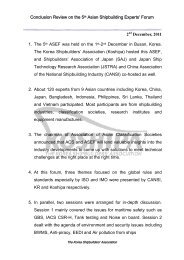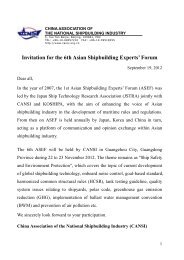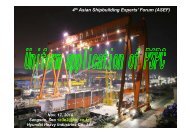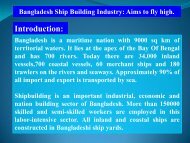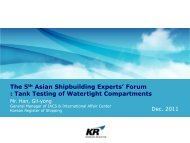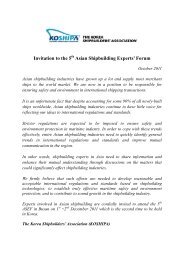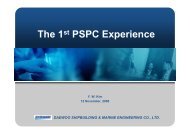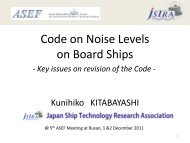4. Study on the Risk-Based Methodology for Ship Structural Design
4. Study on the Risk-Based Methodology for Ship Structural Design
4. Study on the Risk-Based Methodology for Ship Structural Design
You also want an ePaper? Increase the reach of your titles
YUMPU automatically turns print PDFs into web optimized ePapers that Google loves.
C<strong>on</strong>tents1. Safety Level <strong>Based</strong> Hull Scantling Assessment2. Safety Level of Local Supporting Member3. Case <str<strong>on</strong>g>Study</str<strong>on</strong>g><str<strong>on</strong>g>4.</str<strong>on</strong>g> C<strong>on</strong>clusi<strong>on</strong>The 6 th ASEF- 1 -
1.Safety Level <strong>Based</strong>Hull Scantling AssessmentThe 6 th ASEF- 2 -
1. Safety Level <strong>Based</strong> Assessment• <strong>Risk</strong>-<strong>Based</strong> <strong>Design</strong>/Approval of <strong>Ship</strong>‣ New design paradigm based <strong>on</strong> <strong>the</strong> risk assessment‣ This stands <strong>on</strong> probabilistic approach, not deterministic‣ Safety level approach is <strong>on</strong>e of <strong>the</strong> key methodology <strong>for</strong> RBD/A‣ Activities to apply RBD/A into ship design/approval (e.g. IMO GBS)Change of MarketEnvir<strong>on</strong>mentTechnicalInnovati<strong>on</strong>New Regulati<strong>on</strong>sNovel<strong>Ship</strong> <strong>Design</strong>Optimal<strong>Ship</strong> <strong>Design</strong>Enhanced Safetyof <strong>Ship</strong>Eco-Friendly<strong>Ship</strong>Increase of Needsto RBD/AFor <strong>Ship</strong>The 6 th ASEF- 3 -
1. Safety Level <strong>Based</strong> Assessment• RBD/A <strong>for</strong> <strong>Ship</strong> Structure‣ Rule based assessment <strong>on</strong> structural safety (currently underway)TargetSafetyLevelCalibrati<strong>on</strong>ofPartial SafetyFactorPrescriptive<strong>Structural</strong>RuleFormula(stringent)ScantlingRequirements<strong>for</strong><strong>Structural</strong>MembersDecisi<strong>on</strong>-makingby ComparingActual <strong>Design</strong>with RuleRequirement<strong>Structural</strong> Reliability Analysis‣ Safety level based assessment <strong>on</strong> structural safety (this study)TargetSafetyLevelCalculati<strong>on</strong>Methods<strong>for</strong><strong>Structural</strong>Safety LevelGuidelines<strong>for</strong><strong>Structural</strong>Safety Level(flexible)ActualSafety LevelofProposed<strong>Design</strong>Decisi<strong>on</strong>-makingby ComparingActual SafetyLevel withTarget Level<strong>Structural</strong> Reliability AnalysisThe 6 th ASEF- 4 -
1. Safety Level <strong>Based</strong> Assessment• Overview of Assessment ProcedureSTEP 1C<strong>on</strong>cerned<strong>Structural</strong>MemberC<strong>on</strong>cernedFailureModeInitialScantlingSTEP 3LimitStateEquati<strong>on</strong><strong>Design</strong>Variables(Uncertainty)STEP 4<strong>Structural</strong>ReliabilityAnalysisSTEP 2TargetSafetyLevelSTEP 5<strong>Design</strong>SafetyLevelSAFEAppropriateInitial ScantlingSTEP 6Yes<strong>Structural</strong>SafetyEvaluati<strong>on</strong>- DSL ≥ TSL ?- DocumentVerificati<strong>on</strong>NoTo be defined obviously by <strong>the</strong> SLA-based Procedure and/or c<strong>on</strong>ducted by ApproverTo be determined and/or c<strong>on</strong>ducted by <strong>Ship</strong> Structure <strong>Design</strong>erUNSAFEInappropriateInitial ScantlingTo be determined by <strong>Ship</strong> Structure <strong>Design</strong>er in accordance with <strong>the</strong> guideline in <strong>the</strong> SLA-based ProcedureThe 6 th ASEF- 5 -
1. Safety Level <strong>Based</strong> Assessment• Step 1. <strong>Design</strong> Scope‣ To select initial scantling and c<strong>on</strong>cerned failure mode• Dimensi<strong>on</strong>, locati<strong>on</strong>, material, corrosi<strong>on</strong>, c<strong>on</strong>figurati<strong>on</strong>, etc.• Yielding, buckling, fatigue, impact, etc.• Step 2. Target Safety Level‣ Safety goal, i.e. <strong>the</strong> smallest allowable level securing safety‣ C<strong>on</strong>sidering member type, failure mode and damage c<strong>on</strong>sequence• Step 3-1. Limit State Equati<strong>on</strong>‣ <strong>Design</strong> criteria: Z = R – L (R & L: resistance & load factor)‣ Z = 0 : boundary between safe and fail‣ Probability of failure is <strong>the</strong> likelihood that Z < 0 occursThe 6 th ASEF- 6 -
1. Safety Level <strong>Based</strong> Assessment• Step 3-2. <strong>Design</strong> Variables‣ Probabilistic modeling is necessary‣ Categorizati<strong>on</strong> of design variables• Related to loads acting <strong>on</strong> hull• Related to materials• Related to uncertainties in fabricati<strong>on</strong>• Related to uncertainties in structural modeling and mechanics• Step <str<strong>on</strong>g>4.</str<strong>on</strong>g> <strong>Structural</strong> Reliability Analysis‣ There are various techniques established well at present• M<strong>on</strong>te-Carlo simulati<strong>on</strong>, FOSM, SOSM and so <strong>for</strong>th‣ From <strong>the</strong> SRA, probability of failure can be producedThe 6 th ASEF- 7 -
1. Safety Level <strong>Based</strong> Assessment• Step 5. <strong>Design</strong> Safety Level‣ Quantitative safety inherent in <strong>the</strong> structural member‣ The actual safety level ensured by <strong>the</strong> structural design proposed‣ It could be estimated c<strong>on</strong>sidering failure probability and operati<strong>on</strong> plan• Step 6. <strong>Structural</strong> Safety Evaluati<strong>on</strong>‣ First, document verificati<strong>on</strong> is necessary• All <strong>the</strong> works d<strong>on</strong>e by designer should be verified to be reas<strong>on</strong>able‣ Sec<strong>on</strong>d, comparing <strong>the</strong> DSL with <strong>the</strong> TSL is necessary• If DSL is not less than <strong>the</strong> TSL, current design is safe enough• O<strong>the</strong>rwise, current design is to be amended to make its structural safetylevel higherThe 6 th ASEF- 8 -
2.Safety Level of LSM(Local Supporting Member)The 6 th ASEF- 9 -
2. Safety Level of LSM• Formulati<strong>on</strong> of Limit State Equati<strong>on</strong>Z R L WorkingLMTWorking2sP P M C M WKStatWKDynfbendzWKStatWKDynHGvert• Failure mode c<strong>on</strong>cerned Yielding failure of local stiffener, due to local bending• Load type c<strong>on</strong>cerned Local loads: lateral pressure from external sea and internal ballast/cargo Global loads: vertical wave bending moment• Resistance factor (R) = yield stress capacity of <strong>the</strong> material used• Load factor (L) = working stress <strong>on</strong> <strong>the</strong> stiffener c<strong>on</strong>sidered• Background Beam <strong>the</strong>ory (both ends fixed) Scantling <strong>for</strong>mulas in IACS CSR <strong>for</strong> double hull oil tanker Net scantling approachstiffScale0.001dIvertThe 6 th ASEF- 10 -
2. Safety Level of LSM• C<strong>on</strong>siderati<strong>on</strong> <strong>on</strong> <strong>Design</strong> VariablesZ R L WorkingNominal yield stress of materialLMTWorking2sP P M C M WKStatSpacing & bending spanof stiffenerWKDynfbendzstiffWKStatVertical distancefrom N.A. to stiffenerNet vertical hull girdermoment of inertiaScaleWKDyn0.001dIvertHGvertLocal pressureacting <strong>on</strong> stiffener(static)Local pressureacting <strong>on</strong> stiffener(dynamic)BendingmomentfactorNet secti<strong>on</strong>modulusof stiffenerStillwaterbendingmomentCorrecti<strong>on</strong>factor(<strong>for</strong> IACSUR 11)VerticalwavebendingmomentThe 6 th ASEF- 11 -
2. Safety Level of LSM• Calculati<strong>on</strong> of <strong>Design</strong> Safety Level‣ Direct Load Analysis• is c<strong>on</strong>sidered as more reas<strong>on</strong>able than simplified <strong>for</strong>mulas that are based<strong>on</strong> plenty of assumpti<strong>on</strong> and idealizati<strong>on</strong>• is essential to probabilistic modeling of dynamic loads‣ Probability of failure can be produced by using• SRA (<strong>Structural</strong> Reliability Analysis), established well at present‣ <strong>Design</strong> safety level• For estimating DSL, HPP (Homogeneous Poiss<strong>on</strong> Process) was used• to model occurrences of a specific event within a given time period• Assumpti<strong>on</strong>s<strong>Ship</strong> experiences a wave repeatedly & independently during its lifetimeEvent: occurrence of structural failure while ship goes through a waveDSL equivalent to no occurrence of <strong>the</strong> event throughout ship’s lifetimeThe 6 th ASEF- 12 -
2. Safety Level of LSM• Calculati<strong>on</strong> of <strong>Design</strong> Safety LevelTo calculate Failure Probability (P f ), when <strong>the</strong> vessel experiences a wavehaving a specific directi<strong>on</strong> (headingangle) in a given loading c<strong>on</strong>diti<strong>on</strong>.To combine <strong>the</strong> Probabilities calculated, in case <strong>on</strong>e wave approaches <strong>the</strong> vessel, c<strong>on</strong>sidering all <strong>the</strong> possible loadingc<strong>on</strong>diti<strong>on</strong>s and wave directi<strong>on</strong>s.To estimate <strong>Design</strong> Safety Level, that means <strong>the</strong> probability ofno structural failure occurrencethroughout <strong>the</strong> vessel’s lifetime.Pf LC, angle Z(LC,angle)Z 0Pf LC ranglePfLC,angleanglePf<strong>on</strong>ewave rLCPfPSafe<strong>Design</strong>LCLC P(n 0, T) ePf <strong>on</strong>ewaveLC – a given loading c<strong>on</strong>diti<strong>on</strong>angle – a given wave directi<strong>on</strong> (heading angle)r angle – ratio of each wave directi<strong>on</strong> to 360 Or LC – ratio of each loading c<strong>on</strong>diti<strong>on</strong> to lifetimeT – vessel’s lifetime (design life)n – number of occurrence of specific failure eventHomogeneous Poiss<strong>on</strong> Processn( T)TP( n,T) e <strong>for</strong> n 0, 1, 2, n!TThe 6 th ASEF- 13 -
3.Case <str<strong>on</strong>g>Study</str<strong>on</strong>g>The 6 th ASEF- 14 -
3. Case <str<strong>on</strong>g>Study</str<strong>on</strong>g>• Step 1. <strong>Design</strong> Scope (1/3)‣ Subject vessel• Type : Double hull oil tanker (AFRAMAX class)• Dead weight : 105,000 T<strong>on</strong>• Principle dimensi<strong>on</strong> : 234m (LBP) x 42m (B) x 21.2m (D)• Draught : 15m• Applied rule : IACS CSR-Oil Tanker, RCN No.1• Delivery : September 2008‣ <strong>Structural</strong> member c<strong>on</strong>cerned• A bottom l<strong>on</strong>gitudinal stiffener located at midship• A kind of LSM (local supporting member)‣ Failure mode c<strong>on</strong>cerned• Yield strength resisting local bending due to both lateral pressure andvertical wave bending momentThe 6 th ASEF- 15 -
3. Case <str<strong>on</strong>g>Study</str<strong>on</strong>g>• Step 1. <strong>Design</strong> Scope (2/3)Details of <strong>Structural</strong> MemberScantling (gross)Corrosi<strong>on</strong> additi<strong>on</strong>450x11+150x22 F.B(T)3.0 mmSecti<strong>on</strong> modulus (100% net) 1,762.9 cm 3MaterialHT32 (A-grade)Load calculati<strong>on</strong> point (m) x=118.34/ y=8.3/ z=0Stiffener spacing830 mmEffective bending span <str<strong>on</strong>g>4.</str<strong>on</strong>g>030 mInner Bottom PlatingBottom PlatingBTM L<strong>on</strong>gL. Stiff. No.10The 6 th ASEF- 16 -
3. Case <str<strong>on</strong>g>Study</str<strong>on</strong>g>• Step 1. <strong>Design</strong> Scope (3/3)<strong>Design</strong> C<strong>on</strong>diti<strong>on</strong>s AssumedNominaldesign lifeExternalenvir<strong>on</strong>mentInternalenvir<strong>on</strong>mentLoading c<strong>on</strong>diti<strong>on</strong>Wave spectrum• 25 years• Operating in North Atlantic wave envir<strong>on</strong>ment <strong>for</strong> its entire life• Effects of wind, current, ice, low temperature ignored• Identical to those defined in IACS CSR-Oil Tanker• Operating <strong>for</strong> 85% of <strong>the</strong> design life(n<strong>on</strong>-operating <strong>for</strong> 15% of <strong>the</strong> design life)• Full loading c<strong>on</strong>diti<strong>on</strong> <strong>for</strong> 45% of <strong>the</strong> design life• Normal ballast c<strong>on</strong>diti<strong>on</strong> <strong>for</strong> 40% of <strong>the</strong> design life• 2-parameter Piers<strong>on</strong>-Moskowitz spectrumThe 6 th ASEF- 17 -
3. Case <str<strong>on</strong>g>Study</str<strong>on</strong>g>• Step 2. Target Safety Level‣ For example, MSC 79/6/15 was c<strong>on</strong>sideredTarget Safety LevelTarget Failure Level(<strong>for</strong> entire design life)= 10 -4 x 25 years= 2.5 x 10 -3 P<strong>for</strong> design life Safe-Target = 1 – 2.5 x 10 -3= 0.9975The 6 th ASEF- 18 -
3. Case <str<strong>on</strong>g>Study</str<strong>on</strong>g>• Step 3-1. Limit State Equati<strong>on</strong>‣ <strong>Structural</strong> member• L<strong>on</strong>gitudinal ordinary stiffener‣ Failure mode• Yield failure of local stiffener, due to local bending‣ Loads• Local load - lateral pressure• Global load - vertical wave bending momentZ R L WorkingLMTWorking2sP P M C M WKStatWKDynfbendzstiffWKStatScaleWKDyn0.001dIvertHGvertThe 6 th ASEF- 19 -
3. Case <str<strong>on</strong>g>Study</str<strong>on</strong>g>• Step 3-2. <strong>Design</strong> Variables (1/3)‣ Stochastic modeling of <strong>the</strong> design variables<strong>Design</strong>VariablesUnitDistributi<strong>on</strong>TypeDistributi<strong>on</strong>ParametersReference LMTN/mm 2 Lognormal Mean=348/ CoV=0.06 MSC 81/INF.6P WK-Stat kN/m 2 C<strong>on</strong>stant150.829 <strong>for</strong> full loading69.884 <strong>for</strong> normal ballastIACS CSR-Oil TankerP WK-Dyn kN/m 2 Weibull Refer to <strong>the</strong> next slide DLA (Direct Load Analysis)M WK-Stat kN-m Normal Mean=1,950,228/ CoV=0.2857MSC 81/INF.6 (70% of permissiblemoment c<strong>on</strong>sidered <strong>for</strong> <strong>the</strong> example)M WK-Dyn kN-m Weibull Refer to <strong>the</strong> next slide DLA (Direct Load Analysis)s, l mm, n Normal Mean=830, <str<strong>on</strong>g>4.</str<strong>on</strong>g>03/ CoV=0.04 SSS-93f bend - C<strong>on</strong>stant 12 <strong>for</strong> both ends fixed IACS CSR-Oil Tankerz stiff cm 3 Normal Mean=1762.9/ CoV=0.04 SSS-93C Scale - C<strong>on</strong>stant Refer to <strong>the</strong> next slide DLA & IACS UR S11d vert m Normal Mean=8.845/ CoV=0.04 SSS-93I HG-vert m 4 Normal Mean=35<str<strong>on</strong>g>4.</str<strong>on</strong>g>492/ CoV=0.04 SSS-93The 6 th ASEF- 20 -
3. Case <str<strong>on</strong>g>Study</str<strong>on</strong>g>• Step 3-2. <strong>Design</strong> Variables (2/3)‣ Stochastic modeling of dynamic lateral pressureWeibull Distributi<strong>on</strong>• Lower bound = 0• h: shape parameter• q: scale parameterPWK Dyn F(x) 1[kN/m 2 ] e x q hHeadingAngle(degree)Full Loading C<strong>on</strong>diti<strong>on</strong>ShapeParameterScaleParameterNormal Ballast C<strong>on</strong>diti<strong>on</strong>ShapeParameterScaleParameter0 1.03737 1.68135 1.04434 1.7303830 1.03464 1.98516 1.04854 1.7050060 1.03056 2.38922 1.05558 1.5975390 1.02734 2.70590 1.05422 1.47172120 1.02567 2.48912 1.05489 1.49974150 1.02644 1.88106 1.05284 1.63043180 1.04162 1.43410 1.05308 1.67741210 1.02964 2.77332 1.05512 2.52563240 1.02707 3.67518 1.05519 2.85417270 1.02720 <str<strong>on</strong>g>4.</str<strong>on</strong>g>26562 1.05403 3.16280300 1.03519 3.63436 1.05661 2.69334330 1.03740 2.72686 1.05540 2.33878It is assumed <strong>the</strong> occurrence probability of each heading angle is 0.0833 (=1/12).The 6 th ASEF- 21 -
3. Case <str<strong>on</strong>g>Study</str<strong>on</strong>g>• Step 3-2. <strong>Design</strong> Variables (3/3)‣ Stochastic modeling of vertical wave bending momentWeibull Distributi<strong>on</strong>• Lower bound = 0• h: shape parameter• q: scale parameterMWK Dyn F(x) 1[kN-m] e x q hHeadingAngle(degree)ShapePara.Full Loading C<strong>on</strong>diti<strong>on</strong>ScalePara.C ScaleShapePara.Normal Ballast C<strong>on</strong>diti<strong>on</strong>ScalePara.C Scale0 1.02534 270034 0.826 1.03677 229781 1.00030 1.03145 254465 0.891 1.04077 212142 1.00060 1.05452 231936 1.000 1.05602 173345 1.00090 1.05484 203519 1.000 1.05810 153381 1.000120 1.04259 223626 1.000 1.05848 195326 1.000150 1.02804 265590 0.846 1.05055 239661 0.993180 1.02294 282137 0.785 1.04797 256419 0.923210 1.03145 254465 0.891 1.04077 212142 1.000240 1.05452 231936 1.000 1.05602 173345 1.000270 1.05484 203519 1.000 1.05810 153381 1.000300 1.04259 223626 1.000 1.05848 195326 1.000330 1.02804 265590 0.846 1.05055 239661 0.993It is assumed <strong>the</strong> occurrence probability of each heading angle is 0.0833 (=1/12).The 6 th ASEF- 22 -
3. Case <str<strong>on</strong>g>Study</str<strong>on</strong>g>• Step <str<strong>on</strong>g>4.</str<strong>on</strong>g> <strong>Structural</strong> Reliability Analysis‣ By MC simulati<strong>on</strong> & AFOSM (Advanced First Order Sec<strong>on</strong>d Moment)Heading Angle(degree)Probability of FailureFull LoadingP f-full, angleNormal BallastP f-ballast, angleP r Pfull, 0 8.79 x 10 -12 2.82 x 10 -16f full angle f330 1.01 x 10 -11 2.66 x 10 -1630 9.26 x 10 -12 2.85 x 10 -17angle60 6.25 x 10 -12 6.04 x 10 -2090 1.22 x 10 -12 2.93 x 10 -21120 5.65 x 10 -12 9.58 x 10 -19P150 9.07 x 10 -12 2.46 x 10 -16f <strong>on</strong>ewave rfullPf full180 8.42 x 10 -12 2.59 x 10 -16210 1.03 x 10 -11 3.15 x 10 -17240 7.69 x 10 -12 7.56 x 10 -20270 1.77 x 10 -12 <str<strong>on</strong>g>4.</str<strong>on</strong>g>26 x 10 -21 There<strong>for</strong>e,300 6.79 x 10 -12 1.14 x 10 -18 P f <strong>on</strong>ewave 3.19910Pf ballast ranglePfballast,angleangleangle• r angle: it is assumed to be 0.083 (equally). rballastf ballast• r full = 0.45 (ratio of full loading c<strong>on</strong>d.)• r ballast = 0.40 (ratio of normal ballast c<strong>on</strong>d.)12PThe 6 th ASEF- 23 -
3. Case <str<strong>on</strong>g>Study</str<strong>on</strong>g>• Step 5. <strong>Design</strong> Safety Level‣ <strong>Design</strong> safety level (P Safe-<strong>Design</strong> ) was estimated• <strong>on</strong> <strong>the</strong> basis of HPP (Homogeneous Poiss<strong>on</strong> Process)n( T)TP( n)T totalnumber of waves e <strong>for</strong> n 0, 1, 2, n!• It means, within <strong>the</strong> time interval (T), a specific event having <strong>the</strong> intensity of λ could occurn-times independently with <strong>the</strong> probability of P(n).8 0( P88f <strong>on</strong>ewave10) P 1010(0)f <strong>on</strong>ewave Pf<strong>on</strong>ewavePSafe<strong>Design</strong> P8 e eT 10 0!• <strong>Structural</strong> failure when <strong>the</strong> vessel experiences <strong>on</strong>e wave is defined as <strong>the</strong> event• T is defined as 10 8 , based <strong>on</strong> <strong>the</strong> assumpti<strong>on</strong> that <strong>on</strong>e wave approaches <strong>the</strong> vessel every 10 sec<strong>on</strong>ds• P Safe-<strong>Design</strong> means <strong>the</strong> probability of no event occurrence throughout <strong>the</strong> design life of 25 years n = 0 & λ = P f-<strong>on</strong>e wave• There<strong>for</strong>e,PSafe<strong>Design</strong> P(0)T 128(3.19910) 108 e100.9997The 6 th ASEF- 24 -
3. Case <str<strong>on</strong>g>Study</str<strong>on</strong>g>• Step 6. <strong>Structural</strong> Safety Evaluati<strong>on</strong>‣ Current design of <strong>the</strong> stiffener is safe enough both• From a viewpoint of “safety level approach”Calculated DSL is larger than <strong>the</strong> TSL defined P Safe-<strong>Design</strong> = 0.9997 > P Safe-Target = 0.9975• From a viewpoint of “deterministic approach”Actual S.M. is larger than <strong>the</strong> required S.M. by IACS CSR S.M net-Actual = 1762.9 cm 3 > S.M net-Req = 1317.98 cm 3‣ Fur<strong>the</strong>r examinati<strong>on</strong> <strong>on</strong> design modificati<strong>on</strong>CaseDimensi<strong>on</strong>Actualnet S.M.(cm 3 )<strong>Design</strong>safetylevelAssessment based <strong>on</strong>Deterministic approach(IACS CSR)Safety levelapproachOriginal 450x11 + 150x22 F.B(T) HT32 1762.9 0.9997 SAFE SAFERevisi<strong>on</strong> 1 450x11 + 150x20 F.B(T) HT32 1675.5 0.9990 SAFE SAFERevisi<strong>on</strong> 2 450x11 + 150x18 F.B(T) HT32 1507.8 0.9877 SAFE FAILThe 6 th ASEF- 25 -
<str<strong>on</strong>g>4.</str<strong>on</strong>g>C<strong>on</strong>clusi<strong>on</strong>The 6 th ASEF- 26 -
<str<strong>on</strong>g>4.</str<strong>on</strong>g> C<strong>on</strong>clusi<strong>on</strong>• In this study,‣ Necessity of <strong>Risk</strong>-based design/approval <strong>for</strong> ship was menti<strong>on</strong>ed‣ Safety level based procedure <strong>for</strong> scantling assessment was proposed‣ Regarding yield strength of LSM (e.g. l<strong>on</strong>gitudinal stiffener),• limit state equati<strong>on</strong> was <strong>for</strong>mulated• stochastic modeling of dynamic loads by using DLA was attempted• design safety level calculati<strong>on</strong> based <strong>on</strong> failure probability was invented‣ And, calculati<strong>on</strong> of <strong>on</strong>e example case was carried out• As a result,‣ It has been found that specific safety level of a given structural designcould be quantified in c<strong>on</strong>siderati<strong>on</strong> of;• ship’s operating scheme (i.e. time dependent safety level) as well as• deviati<strong>on</strong>, that is potential while c<strong>on</strong>structing, from <strong>the</strong> intended designThe 6 th ASEF- 27 -
<str<strong>on</strong>g>4.</str<strong>on</strong>g> C<strong>on</strong>clusi<strong>on</strong>• C<strong>on</strong>siderati<strong>on</strong> <strong>on</strong> Applicability‣ Target safety levels <strong>for</strong> ship structural members are to be established,• <strong>on</strong> <strong>the</strong> basis of agreement am<strong>on</strong>g various maritime stakeholders‣ Regarding design variables, <strong>the</strong> followings are needed;• Loads – more active utilizati<strong>on</strong> of direct load analysis• Material – statistical analysis of measured data <strong>on</strong> material properties• Fabricati<strong>on</strong> – investigati<strong>on</strong> <strong>on</strong> <strong>the</strong> quality c<strong>on</strong>trol capacity of ship-yards• Modeling – <strong>the</strong>oretical research <strong>on</strong> related mechanics‣ Calculati<strong>on</strong> tools should be provided to users;• S/W <strong>for</strong> DLA – several S/Ws were developed well and are being used• S/W <strong>for</strong> Statistical analysis of DLA results – fur<strong>the</strong>r development necessary• S/W <strong>for</strong> SRA – several S/Ws were developed well and are being used• S/W <strong>for</strong> GUI – possible to use <strong>the</strong> scantling S/W with slight modificati<strong>on</strong>The 6 th ASEF- 28 -
The 6 th ASEF- 29 -




